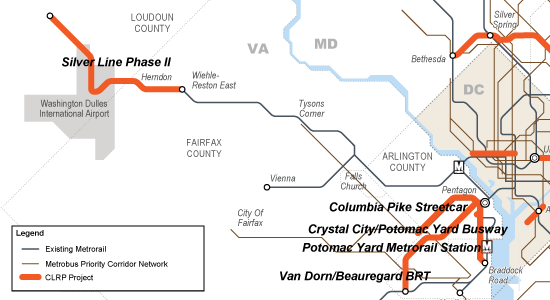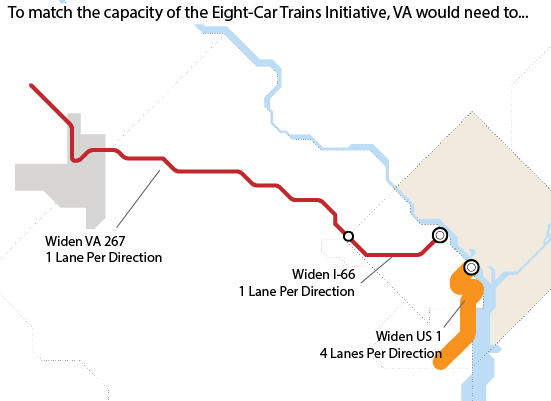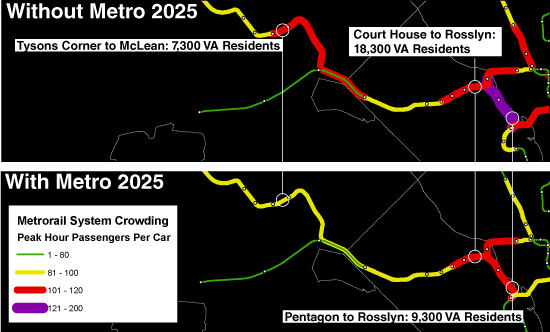What Metro 2025 Means to Virginia
Metro 2025 would bring significant benefits to northern Virginia, allowing the region to thrive economically while preserving regional vitality.
Think Metro’s Momentum plan is all about “downtown?” Think again! Our seven Metro 2025 initiatives – from eight-car trains to bus-only lanes will bring dramatic improvements to the quality of life and transportation to northern Virginia.
Supports Virginia Transit Projects
Virginia is planning big for transit, which is great – but all of the planned projects rely on a robust Metrorail and Metrobus “backbone” to succeed:
- The Silver Line extends Metrorail by over 20 miles, and will generate tens of thousands of new riders per day when Phase II opens – many of whom will travel into Metrorail’s already congested core.
- The Columbia Pike Streetcar will transfer 32,000 riders per day to and from Metrorail at Pentagon City – at a point in the system that is already maxxed out.
- Two other planned busways (Crystal City/Potomac Yard, and Van Dorn/Beauregard) also connect with Metrorail stations.

All major transit projects funded in the CLRP in Northern Virginia depend on the “backbone” of Metrorail and Metrobus.
By ensuring that Metro services can keep pace with congestion and demand, Metro 2025 is critical to making Virginia’s transit projects a success, and critical to helping the region and the state reach its transportation goals.
![]()
Supports Virginia’s Growing Economy
Northern Virginia’s population is growing steadily, and economic and population growth is only projected to continue for decades. And this region is crucial to Virginia’s economy – 47% of the state’s economic output came from Northern Virginia in 2012. With this growth comes significant transportation needs, and Metro 2025 is critical to meeting that growth.
- Since 2000, the population in of Northern Virginia has grown by 15%
- By 2040, northern Virginia is projected to see an influx of over 415,000 jobs (PDF), or an increase of 42%.
- To handle this growth, Virginia needs the rail and bus system that Metro 2025 would deliver: 8-car trains capable of moving the equivalent of 16-18 lanes of highways (in each direction) throughout the region, superior bus service, and more.
Alternatively, if we were to support this growth with highway investments, we could need the equivalent of 110 lane-miles of pavement in Virginia, including four new arterial lanes and one freeway lane in each direction through Arlington, Alexandria, Falls Church, Fairfax City, and Fairfax County. This investment in Virginia alone could reach upwards of $795 million.
Consider this – adding two extra cars to every Orange and Silver Line train through Arlington is the trip capacity equivalent of widening I-66 by two lanes – at a fraction of the cost.

To match the same capacity as Metro 2025, Virginia would have to build four lanes of arterial roadways in each direction (yellow in the map above) and one freeway lane in each direction (shown in red).
Relieves Crowding on Trains and Buses
Metrorail and Metrobus are running at or above capacity, and Virginia residents feel it every day.
- Today, over 18,000 Virginians each day experience uncomfortably crowded conditions on-board Metrorail, expected to double to nearly 40,000 Virginia residents by 2025.
- Over 20,000 Virginia residents each day pass through a crowded Metrorail station – often encountering lines for elevators, escalators, or fare gates.
- At the same time, over 2,000 Virginia residents every day ride a crowded Metrobus.
- Without Metro 2025, crowding on Metrorail is projected to more than double (increase by 113%).
Running all 8-car trains at peak times cuts the number of riders experiencing crowding from 26% to 9%, especially at peak load points such as: Rosslyn, Pentagon, and Tysons Corner.

Metro 2025 will relieve significant crowding for over 40,000 Virginia residents at peak load points on-board Metrorail during the peak hour in 2025.
Saves Time and Money for Virginia Riders and Drivers Alike
By simultaneously taking 135,000 cars off the road and improving transit, Metro 2025 saves time for both transit riders and drivers.
- Metro 2025 takes over 35,000 cars off Virginia roads every day, reducing traffic jams and air pollution
- Virginians would enjoy buses that move faster, and Metrorail riders will move faster through the system due to less station congestion. This will save Virginia residents time worth $51 million per year.
- Virginia riders and drivers alike would save another $39 million per year in out-of-pocket travel costs like gas and car maintenance.
![]()
Reduces Costs to Virginia
Metro 2025 will make Metro more efficient, allowing us to reinvest the savings in more service, or reduce the subsidy required from our funding partners.
- For example, the Metrobus Priority Corridor Network could increase bus speeds by up to 50% on some routes, saving over $500,000 in annual operating costs for Virginia share of the PCN routes.
- Eight-car trains and station capacity improvements may translate into real savings by avoiding the costs of delays caused by crowding in the future. If Metro 2025 prevents increases in train dwell times, this could prevent an increase in peak operating costs of up to ten percent for Metrorail. This would equal avoiding a subsidy reduction of over $2.3 million per year for Virginia. Additionally, if the improvements in travel speed can prevent increases in our peak rail vehicle requirement by up to 32 rail cars, this could translate into in a one-time savings of up to $23 million for Virginia.
Makes Metro More Reliable
Finally, Metro 2025 makes Metro a more reliable transit system. Pocket tracks and crossovers would allow Metrorail to better match rail service with demand. For maintenance, this special trackwork would allow us to more effectively operate around planned work. Buses in their own lane with signal priority allows us to better maintain bus spacing and keep pace with the impacts from traffic congestion.


I’m not a fan of the CP streetcar idea at all. I lived on S. Scott St. and although I agree that transit on this major corridor needs improvement, a streetcar running in mixed traffic is not the best solution for riders. There is already a bulb out at the Pentagon station for a future CP line. I say use it and create another Rosslyn-Ballston type corridor, perhaps at a smaller scale. Have the line run underground to Bailey’s then aerial along Route 7 to 7 Corners, underground to a downtown FC station and then link up with the orange line at WFC. In fact, this may be an alternate route for the silver line which will avoid the Rosslyn bottleneck. Sure, some riders will have to transfer, but in this day and age with investment in surburban development, jobs outside of the downtown core, the original hub/spoke system just isn’t relevant any longer. Just an idea…